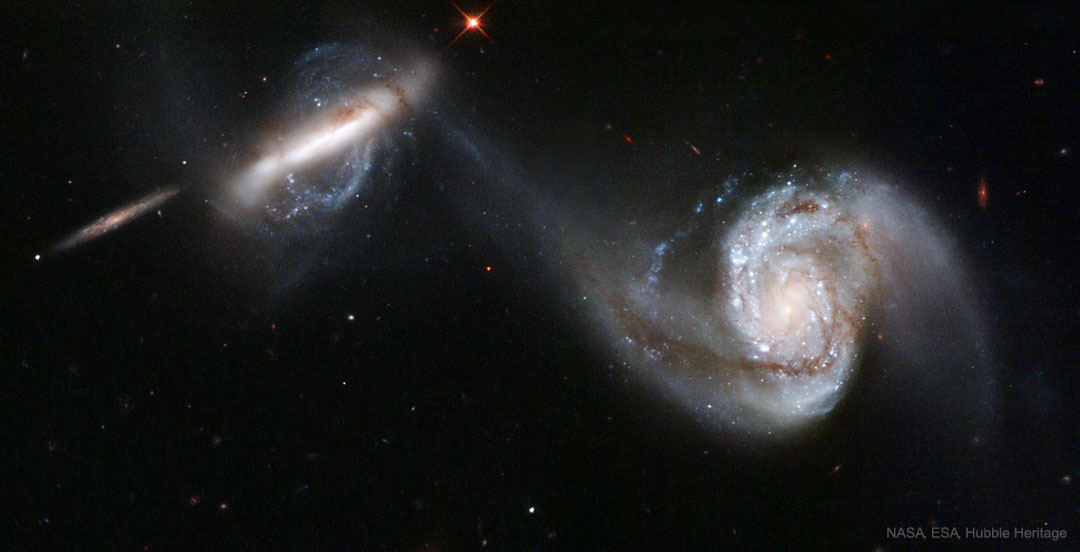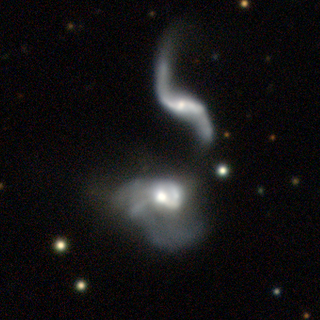Wanneer twee sterrenstelsels samensmelten, zijn er korte periodes van stellaire babybooms. Een groep astronomen onder leiding van Lingyu Wang (SRON) heeft nu een sample gebruikt van ruim 200.000 stelsels om te bevestigen dat fusies de drijvende kracht zijn achter uitbarstingen van stergeboortes. Publicatie in Astronomy & Astrophysics op 21 oktober.

Een van de meest prangende vragen in de sterrenkunde is hoe en wanneer sterren zich vormden in de sterrenstelsels om ons heen. Het heelal bevat honderden miljarden stelsels, in alle soorten en maten. Neem bijvoorbeeld het Sombrerostelsel, het Zwarte Oogstelsel, het Draaikolkstelsel of onze eigen Melkweg die zich uitstrekt over de complete nachthemel. Elk herbergt honderden miljarden fonkelende lichtjes. Hoe en wanneer zijn al die sterren tevoorschijn gekomen op het kosmische toneel?
Een populaire hypothese onder astronomen is dat samensmeltingen van sterrenstelsels hand in hand gaan met korte fases van babybooms en een toename in stervorming met ongeveer een factor twee over de gehele duur van de fusie. Samensmeltingen zouden schokgolven produceren in het interstellaire gas en daarmee significante uitbarstingen van stergeboortes doen ontbranden. Een groep astronomen onder leiding van Lingyu Wang van SRON Netherlands Institute for Space Research, waaronder eerste auteur William Pearson en coauteur Floris van der Tak, hebben deze theorie nu bevestigd door een recordaantal van ruim 200.000 sterrenstelsels te analyseren. Ze vonden tot tweemaal het aantal babybooms in fuserende stelsels vergeleken met losse stelsels.
Deep learning

Omdat hun database zo groot was, heeft het team een deep learning algoritme gebouwd dat zichzelf heeft geleerd om fuserende stelsels te herkennen. Pearson: ‘Het voordeel van kunstmatige intelligentie (KI) is dat het de reproduceerbaarheid van ons onderzoek verbetert, omdat het algoritme consistent is in zijn definitie van een samensmelting. Het is ook een goede voorbereiding voor aankomende surveys die miljarden sterrenstelsels in kaart gaan brengen. Dan kun je niet meer om KI heen. Zelfs citizen science projecten zoals Galaxy Zoo kunnen zulke aantallen niet aan.’
Het is de eerste keer dat astronomen KI hebben gebruikt in het onderzoeksgebied van fuserende stelsels. ‘Dit is een mijlpaal in de zin dat KI een steeds grotere rol zal gaan spelen in ons veld,’ zegt Wang. ‘Maar we moeten er ons bewust van blijven dat de kracht van KI gelimiteerd is tot hoe het is getraind. Als we het een verkeerde definitie voeren van een sterrenstelselfusie, dan doet het zijn werk niet goed.’
Publicatie
W. J. Pearson, L. Wang, M. Alpaslan, I. Baldry, M. Bilicki, M. J. I. Brown, M. W. Grootes, B. W. Holwerd, T. D. Kitching, S. Kruk, F. F. S. van der Tak, ‘Effect of galaxy mergers on star formation rates‘, Astronomy & Astrophysics
Record-number of over 200,000 galaxies confirm: galaxy mergers ignite star bursts
When two galaxies merge, there are brief periods of stellar baby booms. A group of astronomers led by Lingyu Wang from SRON have now used a sample of over 200,000 galaxies to confirm that galaxy mergers are the driving force behind star bursts. It is the first time that scientists use artificial intelligence in a galaxy merger study. Publication in Astronomy & Astrophysics on October 21st.

One of the most pressing questions in astronomy is how and when stars formed in the galaxies we see around us. The Universe contains hundreds of billions of galaxies and they come in many shapes and forms. Take for example the Sombrero Galaxy, the Black Eye Galaxy, the Whirlpool Galaxy or our own Milky Way stretching across the entire sky. Each harbors hundreds of billions of twinkly lights. How and when did all those stars emerge on the cosmic stage?
A popular hypothesis among astrophysicists is that galaxy mergers go hand-in-hand with short starburst phases and an increase of around a factor two in star formation over the whole duration of the merger. Mergers would produce shock waves in the interstellar gas, igniting significant baby booms of stars. A group of astronomers led by Lingyu Wang from SRON Netherlands Institute for Space Research, including first author William Pearson and co-author Floris van der Tak, now confirm this theory by analyzing a record number of over 200,000 galaxies. They found up to twice the number of star bursts in merging galaxies compared to single galaxies.
Deep learning

Because their database was so large, the team built a deep learning algorithm that taught itself to identify merging galaxies. Pearson: ‘The advantage of artificial intelligence is that it improves the reproducibility of our study, because the algorithm is consistent in its definitions of a merger. Also it’s a good preparation for upcoming surveys that will image billions of galaxies. Then you inevitably need AI. Even citizen science projects such as Galaxy Zoo cannot deal with those numbers.’
It is the first time that astronomers have used AI in a merger study. ‘This is a milestone in the sense that AI will play an increasingly large role in our field,’ says Wang. ‘But we have to keep in mind that the power of AI is limited to how it is trained. If we feed it a flawed definition of a galaxy merger, then it won’t do its job correctly.’
Publication
W. J. Pearson, L. Wang, M. Alpaslan, I. Baldry, M. Bilicki, M. J. I. Brown, M. W. Grootes, B. W. Holwerd, T. D. Kitching, S. Kruk, F. F. S. van der Tak, ‘Effect of galaxy mergers on star formation rates‘, Astronomy & Astrophysics


